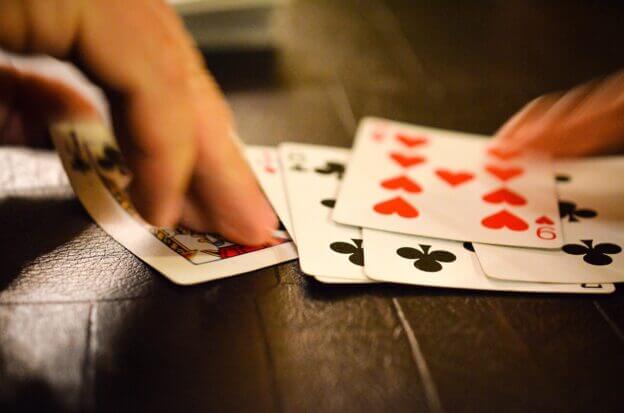The World Series of Poker (WSOP) is the largest and most prestigious poker event globally, which brings tens of thousands of additional visitors to the Las Vegas Strip.
In this article, we will focus on the Pot Limit Omaha (PLO) events, their structure, and how to give yourself the best chance of winning one with a solid PLO strategy!
Understanding PLO Tournament Structures
When choosing a tournament to play, understanding its structure is essential. This includes considering blind levels, stack sizes, re-entries, and bounties.
Blind Levels and Stack Sizes
The first factor to consider is how long you can play deep-stacked against your opponents. The deeper the stack, the larger the game tree, allowing you to exploit weaker players more effectively. A quick way to compare tournaments is to examine the stack sizes relative to the blinds at different times in the tournament, such as after 5 or 10 hours (shorter for online tournaments). Divide the starting stack size by the BB at that level to estimate your BB count.
For example, in the $25k Pot Limit Omaha event, after 10 hours (10 levels), you would still have 37.5BB at your starting stack. In contrast, in the $600 event (with levels increasing twice as fast), you would only have 2BB after the same period, likely being all-in with the ante. Clearly, the $25k event offers more +EV spots for a longer duration. However, this doesn’t mean the $600 event isn’t profitable; it just requires considering all aspects of profitability when selecting tournaments.
You should also make sure that you are getting to the tournament right when it begins, or as close as possible, as late registration is going to cost you valuable hands whereby you will be playing deeper, and reducing your edge
Take a look at JNandez evaluating some of his tournament history and how he looks at tournament structures.
Re-Entries
Checking if your tournament structure allows for re-entries is crucial, as it significantly impacts the dynamics of the early stages. It’s essential to understand the difference between re-entry and rebuy, especially if you’re used to online tournaments where the distinction can be quite significant.
Re-entering a tournament means you will move to a new table as a “new entrant” rather than simply topping up your stack at the same seat. WSOP tournaments use a re-entry format rather than rebuy. This means you should carefully consider your aggressive strategy, especially if you’re in a favorable position against a weaker player. Losing your stack to them might mean you miss the opportunity to win it back in a deeper spot later on.
The impact of rebuys on strategy is more pronounced in faster structures, where building a large stack early becomes a significant advantage. With a large stack, you can apply pressure and bully smaller stacks more effectively after the rebuy period where they will be considerably shorter, and often at risk of elimination.
Bounties
Bounty tournaments are increasingly becoming the go-to structure in many online tournaments, so it’s no surprise that a PLO bounty tournament has been added to the schedule this year with the $1K mystery bounty event. In a bounty tournament, you get paid in cash for knocking out a player. The mystery bounty feature usually means you aren’t eligible to win a player’s bounty until a later stage of the tournament (typically when in the money). For the $1K event, this period starts on the second day.
The impact on tournament strategy, once bounties are eligible to be won, is that the required equity to stack off against someone decreases when you have a chance to knock them out. This is typically calculated by converting the bounty’s dollar value into its chip equivalent and adding it to the denominator in your pot odds calculation. The challenge with a mystery bounty tournament is that you don’t know the bounty amount, so you must use an average bounty estimate, which can be less accurate.
Some general heuristics to remember are that the value of the bounty decreases relative to the value of chips as the tournament progresses, as pay jumps become increasingly important. Also, the risk premiums associated with ICM are generally lower since a portion of the prize pool is unrelated to pay jumps or cashes.
2024 WSOP PLO Tournaments
Here is the WSOP PLO schedule for this year:
If you want to know more details about the events you can check out the events schedule in the WSOP website.
Tips for Succeeding in Tournaments
For a deeper dive into these tips, you can check out our detailed blog post. Here, we’ll scratch the surface of what you should be considering when it comes to PLO tournaments:
Rake Considerations
In Pot Limit Omaha tournaments, the absence of a per-hand rake results in significant adjustments in gameplay, especially for players transitioning from cash games. Understanding these changes is crucial for maximizing profitability in PLO MTTs:
- Marginal Hands Become Playable
Without the rake, hands that might not be profitable in cash games become playable in tournaments. - Increase in Cold Calling
The lack of rake makes cold calling more viable, as you don’t have to compensate for the cost of each hand.
- Reduced 3-Betting
With more cold calling, the frequency of 3-betting decreases, altering pre-flop dynamics. - Antes Act as Reverse Rake
Antes add extra chips to the pot, functioning as a form of reverse rake, which incentivizes seeing more flops. - Strategic Use of Limping
Limping can become a more attractive strategy, especially in late positions, due to the absence of a rake and the presence of antes.
ICM (Independent Chip Model)
One of the fundamental concepts of ICM is that doubling your chips does not necessarily double your tournament equity in terms of dollar value. Similarly, increasing your stack size provides a smaller incremental monetary gain compared to the significant monetary loss incurred by losing an equivalent number of chips. This disproportionate risk encourages a more conservative approach to gameplay when considering ICM, especially in crucial decision-making moments.
Incorrectly handling ICM pressures both pre-flop and post-flop can lead to significant mistakes. Some players may call too liberally in ICM-sensitive stages, only to fold too often post-flop, particularly when up against large stacks who can exert substantial pressure. Adjusting your calling ranges and decision-making to account for the heightened value of chips in these scenarios is crucial.
For example, you might find yourself with 40% equity on the flop and consider pushing all-in; however, ICM considerations could dictate that a push would require a higher equity, perhaps around 65%, to justify the risk. This is because the value of preserving your stack outweighs the potential gain from doubling up in many tournament situations.
How to Prepare for WSOP with PLO Mastermind
PLO Mastermind offers a comprehensive suite of resources to help you prepare for the WSOP and maximize your chances of success in PLO MTTs.
MTT Sims
A critical aspect of MTT play is understanding preflop ranges at various stack sizes, antes, and different stages of the tournament. PLO Trainer covers all these scenarios, including:
- 6-max MTT with Ante
- 6-max MTT without Ante
- 6-max MTT ICM with Ante
- 8-max MTT with Ante
These sims include variations in raise sizes, from 2.5x to pot, and strategies incorporating limping. Post-flop sims are also available, helping you understand how ranges change significantly, impacting post-flop lines and overall strategy.
Conclusion
Preparing for the World Series of Poker (WSOP) Pot Limit Omaha (PLO) tournaments requires a thorough understanding of tournament structures and strategic adjustments. By focusing on factors such as blind levels, stack sizes, re-entries, and bounties, you can better navigate the complexities of PLO events and maximize your edge over the competition.
Understanding the impact of rake considerations and the Independent Chip Model (ICM) on your gameplay is crucial for making informed decisions during the tournament. These concepts help you manage your stack more effectively and avoid common pitfalls that can jeopardize your tournament life.
Leveraging resources like PLO Mastermind can significantly enhance your preparation. With its extensive MTT sims and video courses, you can refine your strategies, understand preflop and post-flop dynamics, and stay ahead of the competition. Whether you’re a novice or an experienced player, the insights and tools provided by PLO Mastermind are invaluable for your WSOP journey.
If you’d like to read more, check out our PLO tournament strategy blog post.






























